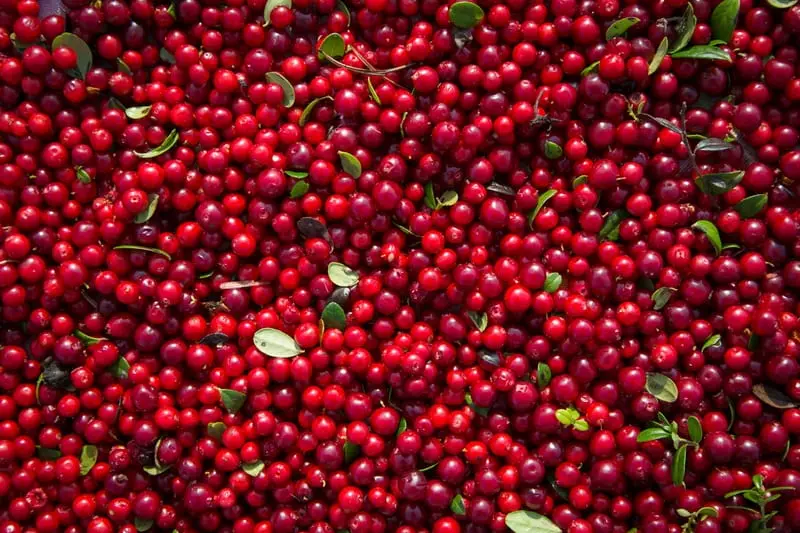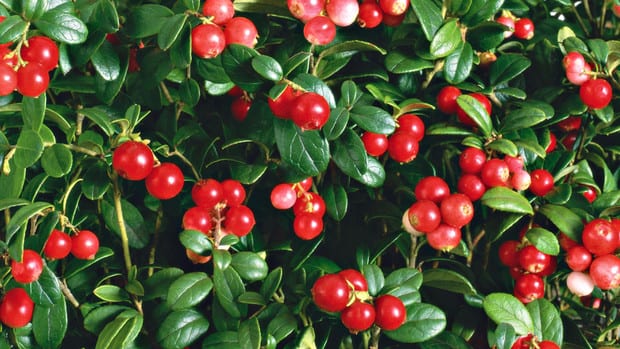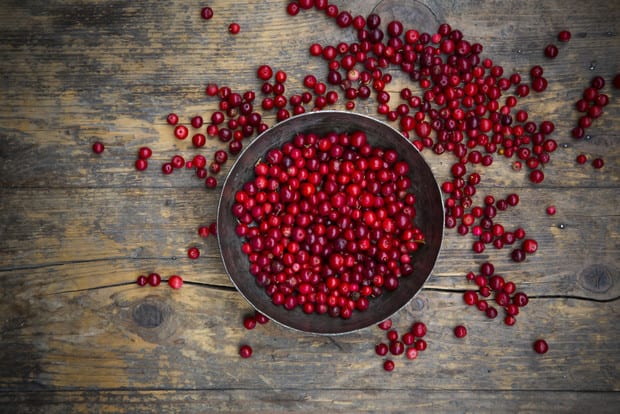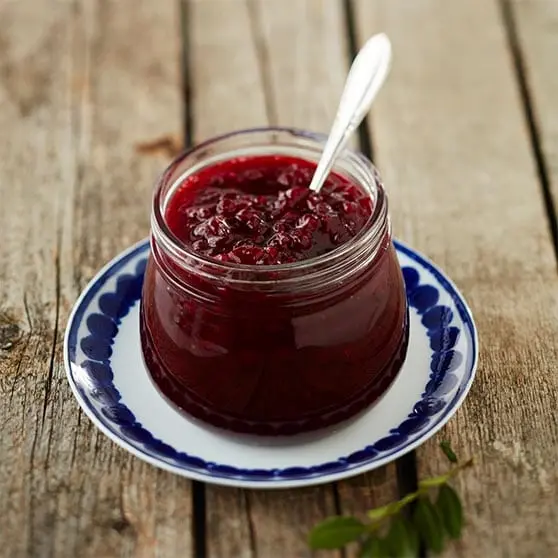Contents
Lingonberry is one of the berries with the most frequent mentions in folk medicine. In terms of efficiency, it is in many ways superior to cranberries and blueberries. Not only red ripe berries have healing power, but also seeds and leaves. In addition, lingonberry is unique in that it retains its medicinal properties even after heat treatment. How to preserve the beneficial properties of lingonberries for the body.
Season
The sweet and sour lingonberry ripens in August-September. Lingonberry is a wild forest berry, but its beneficial properties are familiar to us as early as the 18th century. The first attempts to cultivate lingonberries date back to 1745. In the decree of Empress Elizabeth Petrovna, the demand was expressed to find a way to grow lingonberries in the vicinity of St. Petersburg. Now on sale, you can find both lingonberries harvested in the forests and artificially grown on plantations. In terms of the concentration of nutrients, these two berries are equivalent.
Lingonberry is a fairly low-calorie berry, there are only 46 calories in 100 g. During the diet, it is useful to have a berry smoothie snack or eat it fresh. This scarlet berry contains organic acids (citric, cinchona, lactic, salicylic, malic, benzoic, etc.), pectin, carotene, tannins, vitamins A, C, E, mycalium, calcium, magnesium, manganese, iron and phosphorus.
Lingonberry leaves, which contain tannins, arbutin, hydroquinone, tannin, and carboxylic acids, have medicinal properties. Also gallic, quinic, tartaric acids, and vitamin C. A decoction of lingonberry leaves has a diuretic antiseptic effect. Such a healing drink is often good for women with cystitis, kidney stones, and the problem of edema during pregnancy as a safe natural remedy.
Uses
In the season of colds, doctors advise drinking more berry fruit drinks, juices, and decoctions. Lingonberry juice is perfect as a natural antipyretic for patients at high temperatures. Studies have shown that lingonberry enhances the activity of antibiotics, therefore it is good for fevers, as well as to increase appetite after suffering serious illnesses and injuries.
Lingonberry juice is useful for adults and children, as a tonic and tonic for general weakness, headache, the first signs of a cold. To prepare a healing drink, you need to take 50 g of lingonberry juice diluted with 150 g of chilled boiled water. You can add sugar or honey to taste. You should take the lingonberry drink in the volume of 100 g 3-4 times a day after meals. And, of course, the most favorite recipe from childhood – linden tea and lingonberry jam.
In addition, lingonberry is a natural relaxant. Aromatic lingonberry leaves tea restores strength and relieves fatigue. Small red berries are able to resist hypo – and vitamin deficiencies. Rich in potassium, magnesium, iron and manganese, lingonberry strengthens the immune system. It contains carotene and pectin that improve the condition of the skin and hair. In Russia, girls used cake from lingonberry juice as a nourishing mask for the skin. Lingonberry juice relieves inflammation, refreshes and tones the skin, removes the capillary mesh.
Lingonberry drinks
Drinks from this berry lower blood cholesterol, improve the functioning of the stomach and intestines, and lower blood pressure. Along with blueberries, lingonberries improve visual acuity. It is good for schoolchildren, pilots, and drivers.
Despite the extensive list of useful properties, lingonberries have a number of contraindications. Berries are not healthy for increased gastric secretory function. Lingonberries should not abuse people with low blood pressure, the berry itself and all the drinks and dishes prepared from it help lower blood pressure. In addition, lingonberries absorb and accumulate radioactive substances. You can collect it only away from the roads, factories, technical areas.

Traditional medicine knows this plant as an excellent remedy with healing properties:
Fortifying;
Wound healing;
Antipyretic;
Toning;
Antiscorbutic;
Anthelmintic;
Vitamin;
Diuretic;
Laxative;
Anti-sclerotic;
Choleretic;
Disinfectant, etc.
The main diseases for which lingonberries is a treat:
Colds;
Gastritis (low acidity);
Hepatocholecystitis;
Berries reduce the level of bad cholesterol in the blood, have antiulcer and other medicinal properties. The beneficial properties of lingonberry fruits also lie in the fact that it helps to eliminate toxins and even heavy metal salts. It is useful to use lingonberry at any age, but it brings the greatest benefit to the elderly, as well as to patients suffering from chronic fatigue, low immunity, and healthy people with overwork. For medicinal purposes, both lingonberry fruits and their twigs and leaves are good. Moreover, the leaves include all the nutrients that are in the berries, and also add their own. It has lingonberry and anti-sclerotic effect. It strengthens the walls of blood vessels, heart muscle, it should be eaten by patients with hypertension, ischemic heart disease and rheumatism.
Cosmetological use
Lingonberry is widely popular not only for medicinal purposes and nutrition, but also in cosmetology. Berry masks moisturize and tighten the skin, help prevent wrinkles and aging. Lingonberry extract, which is a natural antioxidant, has a tonic effect on the skin, gives it elasticity, protects from external environmental influences and strengthens the walls of the epidermis. For hair loss, dandruff, skin inflammation, decoctions of lingonberry leaves are used.
Lingonberry juice drink is taken for colds, general weakness, headaches, diluting it with chilled boiled water in a ratio of one to three with the addition of sugar or honey. Drink half a glass after meals three to four times a day.

Calorie content of lingonberry
The calorie content of fresh lingonberries is only 43 kcal per 100 g of berries. At the same time, it contains about 0.7 g of protein, 0.5 g of fat and 9.5 g of carbohydrates. Calorie content and nutritional value may vary slightly depending on the variety.
Types and varieties of lingonberry
It is customary to divide all varieties of lingonberry into European and American. The European one bears fruit twice a year, while the American one bears fruit once. There are more than 20 varieties of lingonberry, most of which can become worthy inhabitants of any site.
Red Pearl is the creation of Dutch breeders. The bush reaches 30 cm in height, has a decorative spherical crown. A feature of the variety is its frost resistance, it can withstand low temperatures, preserving the harvest and maintaining vital activity. In addition to all this, Red Pearl produces crops twice a year. Lingonberry has a sweet and sour taste, with a slight bitterness.
Those who appreciate the composition of lingonberries choose the Rubin variety for planting. The content of useful vitamins and minerals in its composition exceeds their content in other varieties. Blossoming Ruby cannot be confused with other berries – its flowers are in the form of miniature bells. The shrub loves warmth, will not take root in the shade or partial shade. This variety is late, yields later than other varieties, in addition, the first fruits on the bush will appear only 4 years after planting.
The Linnaeus variety bears fruit twice a year
At the end of May and in August. The homeland of this variety is Sweden, and the name is given in honor of the Swedish scientist Linnaeus. The taste is distinguished by a spicy bitterness. Lingonberries will take root only in drained soil.
The Sanna variety is native to Switzerland.
It has a high yield – on average, more than 500 g of berries can be harvested from one bush. The plant of this variety is quite low, reaches a height of 20 to 30 cm, multiplies rapidly, which allows it to be used in landscape design for various compositions, hedges, living forms. This variety is resistant to diseases, does not depend on sunlight, calmly takes root in the shade.
The Kostromichka variety belongs to the early maturing varieties.
The berries are sweet and sour without bitterness. This variety has good frost resistance and good yield. The yield from one square meter can reach 2.5-3 kg.
The most common variety in our country is Coral.
It is a shrub up to 30 cm in height, with the same crown diameter. When grown at home, the variety requires constant watering and moist soil, because this shrub comes from swampy areas. With proper care of this variety of lingonberries, the yield reaches 60 kg from 100 square meters.

Benefits for men
Lingonberries are good for men’s health. It has a diuretic and disinfectant properties, therefore it is effective for prostatitis. The berry tones up the male body, stimulates the muscles, strengthens the walls of blood vessels, lowers blood pressure, and affects potency.
Benefits for women
For women, the berry is indispensable for menopause, helps to cope with mood swings during this period, copes with blood stagnation in the vessels. Lingonberry normalizes the reproductive functions of the female body, regulates hormonal levels, and stabilizes the menstrual cycle. Regular use helps to speed up the conception of the baby.
Lingonberry is especially beneficial for pregnant women, as it relieves puffiness, tones muscles, and the entire body. The berry juice strengthens the child’s bone apparatus, stimulates its full formation.
Lingonberry has a good effect on the skin. It prevents hyperpigmentation of the skin, removes age spots. In addition, lingonberry and its leaves contain antioxidants that cleanse and tighten the skin and protect it from UV radiation and free radicals. Also, the berry strengthens hair, gives it volume, relieves dandruff.
Benefits for children
Lingonberry attracts children with its appearance and taste. This allows you to nourish the child’s body with useful vitamins without resistance, strengthen the immune system and cope with colds. Lingonberry copes with childhood anemia and gastritis. Lingonberry juice will help cope with childhood constipation and intestinal disorders.
The berry will keep the child’s body in good shape, as well as contribute to the rapid recovery of strength during children’s activity.
Harm and contraindications
Irregular consumption of lingonberries can lead to nausea and vomiting, various disorders. In addition, an excess of vitamins that make up the berry can disrupt vital processes in the body.
The use of berries is contraindicated for people with high acidity of the stomach. With ulcers of the gastrointestinal tract, in the presence of kidney stones. It is dangerous to use lingonberries with low blood pressure, as lingonberries can lower it to a critical level, as well as during lactation, as this can lead to intestinal disorders, increased excitability.
For any diseases of the genitourinary system, a doctor’s consultation is required.
Lingonberry jam

Fresh, frozen, dry lingonberries are good in many dishes. Chefs respect their tart taste with bitterness and develop more and more new recipes. It is good with meat and fish dishes. It is a part of healing teas, and the famous lingonberry tincture is also popular among the people. But a special delicacy among adults and children is lingonberry jam. Possessing a bright color, rich taste, lingonberry jam will decorate any festive table, will give warmth on winter evenings.
With centuries of experience in making jam, our housewives have learned how to cook it in many ways. To change the traditional taste, to make it more piquant, to complement the aroma, add fruits and spices to lingonberries during cooking.
The secret to making lingonberry jam lies in the dishes. The container should be wide enough and always with a thick bottom so that the jam heats up quickly and boils evenly. Otherwise, the berries will burst, exfoliate, lose their ruby color.
Cooking
To prepare lingonberry jam with spices, you will need 2 kg of lingonberry, 1 kg of sugar, 2 cinnamon sticks, 8 pieces of dry cloves. Lingonberries sort out, remove the unusable, washed. If you need to remove the astringency of the berries, you need to douse them with boiling water, then pour the lingonberries into the prepared dish, add sugar. Sometimes it is recommended to add a little water, but the berry is juicy, gives juice when boiling, so there is no need for water. The container is put on low heat, after boiling, cloves and cinnamon are added to the jam. When cooking, it is important to stir frequently and remove the foam. The cooking time is 5 minutes. The jam must be cooled and only after that it is laid out in clean jars and rolled up. The jam is stored in a cool place.
Conclusion
The most delicious jam is the combination of lingonberry and pear. To make such a jam, take a kilogram of lingonberries and pears, 2 kg of sugar, half a glass of water. You should wash thу pears, then peel them, core, and cut them into small pieces. Stir water and sugar in a saucepan, put on low heat, add pears and cook for 15 minutes. During cooking, often stir so that the jam does not burn. Pour lingonberries into the resulting syrup. The total cooking time is approximately one hour. Check the redibess as follows: take the boiling jam with a boat and drop it onto a plate, the liquid freezes and does not spread – you can remove it from the heat. Pour the jam into jars and rolled up, the storage location does not matter.










